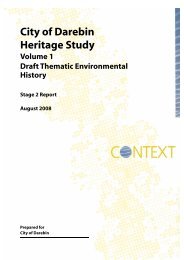INDUSTRIAL LAND USE STRATEGY - City of Darebin
INDUSTRIAL LAND USE STRATEGY - City of Darebin
INDUSTRIAL LAND USE STRATEGY - City of Darebin
Create successful ePaper yourself
Turn your PDF publications into a flip-book with our unique Google optimized e-Paper software.
3.2 Demographic ShiftsIn line with broader trends, the <strong>Darebin</strong>labour-force is shifting to occupations inservice industries. However, the rate <strong>of</strong>change in <strong>Darebin</strong> has been faster than forMelbourne as a whole.The socio-economic divide between thenorth and south <strong>of</strong> the municipality iswidening.The labour-force <strong>of</strong> the southern parts <strong>of</strong>the municipality (the Northcote StatisticalLocal Area) have much higher qualificationsand skills than the metropolitan average:• House prices in this area are up to 50%more than the metropolitan average andprices have increased at a more rapidrate than both Melbourne as a whole andthe northern part <strong>of</strong> the municipality.• People in this area are much more likelyto work in Inner Melbourne than in<strong>Darebin</strong>, and in skilled serviceindustries.The labour-force <strong>of</strong> the northern parts <strong>of</strong>the municipality (the Preston SLA) has lowerqualifications and skills than themetropolitan average:• House prices in this area have risenfaster than the metropolitan averageover the past nine years, but actualprices have only recently achievedparity with the metropolitan average.• People in this area are slightly morelikely to work in <strong>Darebin</strong> than in InnerMelbourne, and in blue collar androutine service industries.Both parts <strong>of</strong> the municipality have highunemployment (over 10%), and this is a realconcern given the sustained period <strong>of</strong>economic growth the Australian economyhas enjoyed.In the second half <strong>of</strong> the 1990s, following anextended period <strong>of</strong> relative decline, InnerMelbourne experienced a period <strong>of</strong> renewedinvestment in economic activity. Thisresurgence has been driven by broadeconomic changes and a concern on the part<strong>of</strong> city decision-makers to ensure thatMelbourne can compete on an internationalscale for economic activity. Privateinvestment in telecommunications, businessservices and entertainment has been intense.There has also been major public investmentin cultural activities and improvements inlifestyle attributes. As a result there aremore jobs and a higher demand for livingspace.This development in Inner Melbournehas rippled outwards, with increasingdemand for housing in middle suburbanareas such as <strong>Darebin</strong>.The southern parts <strong>of</strong> the municipalityespecially have experienced an influx <strong>of</strong>families with workers in the booming InnerMelbourne service economy. Existingworkers in the area have also benefited fromthese jobs.A wave <strong>of</strong> housing renovations andredevelopments has been the mostvisible sign <strong>of</strong> a new affluence in manyparts <strong>of</strong> the area. Unfortunately, this hasnot led to major investment in neweconomic activities in the municipalityeither to take advantage <strong>of</strong> the change inlocal skills or to provide services to newor newly affluent residents.<strong>City</strong> <strong>of</strong> <strong>Darebin</strong> Industrial Land Use Strategy 6
















